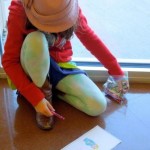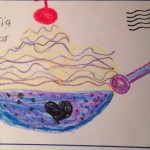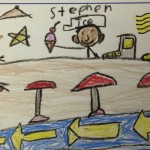Developing “GTMO & GSO”
National Dialogue and Traveling Exhibit
This is the second blog post in a series by our team at the University of North Carolina at Greensboro, as they prepare to host our traveling exhibit. The exhibit will open in Greensboro on December 12.
This part of the semester has been delegated to small group work and this became the detailed development process. We reported on our progress, frustrations, and overall status of the different components of the exhibit. This blog will break down each of the six groups designated from our class, where they started and where they ended in this phase, and the learning experience from this portion of exhibit planning.
Our class is adding three cultural events to the national project. These three events will focus on different aspects of GTMO’s history and how they tie to our local community here in Greensboro. The Cold War, Immigration, and Civil Rights are the three panels being presented to the public. The cultural events team began with attempting to solidify their panelists and this process continued throughout the detailed phase. Every class session revealed more changes and alterations to the panelists and the project discussion with the scholars addressed additional changes that helped us hone our exhibit logo for the project. Phone calling, emailing, letter writing, and attempting to get people to respond to your requests is not always easy but they seem to have stayed positive, though sometimes exasperated, in trying to ensure the panels were well-rounded. The cultural events team have taken these challenges and persevered through difficulty and obstacles that they continually faced in trying to find adequate and interesting panelists. There are still some final commitments that need to be addressed but overall they have accomplished a tremendous amount in such a short time. The learning experience is to ensure the ability to adjust to public concerns or make changes to public events quickly and efficiently since much of the museum’s daily interactions and support come from the public.
The children’s story hour team started this phase with a solid foundation in contacting specific places to conduct the children book readings. The team had to rethink their contacts and places to conduct the children’s story hours through situations outside of their control. The team seemed a little taken aback by the responses but they quickly sought other avenues which proved fruitful. This was a great approach and they quickly added two more events demonstrating that as the proverb says, “The wind from one door closing opens another.” They could have quickly lost hope but they saw other possibilities which are great learning outcomes for museum professionals. Just because something you see as a perfect public partner does not necessarily mean the public partner will understand or appreciate your project. The ability to seek other avenues and reach out to other possible partners is a great way for museums to engage with alternative groups and also learn about other parts of their community they may not originally have considered. Learning to keep our eyes open and accept alternative possibilities is an important skill as we progress in our careers.
- A Young girl drawing her impression of Madlenka and her lost tooth.
- Child’s drawing of Madlenka in Jail.
- A child’s image from UNC-G children’s story hour.
- A child’s drawing from UNC-G children’s story hour
The exhibits team has faced some challenges in the flipbook and entrance/exit poll development. Our class is adding several components to the national exhibit to address how our local community faces similar circumstances to GTMO and how international events affect small town America. There were some considerable challenges to be faced in the detailed development phase and long discussions on these important visual elements were continually held throughout this stage of the process. Both of these added exhibit components have not been completely addressed during the detailed development stage and will continue to be perfected as the final stage proceeds over the next few weeks. This part of the project has been a little slower to form a cohesive idea but as the flipbooks are continually edited, the ideas will come together to create a visual product to enhance the national exhibit. The challenge with the entrance/exit polls are the materials to be used for voting. This process includes several other groups that also need to have input on this part of the project. The learning outcome for the exhibits team is to make final decisions quickly and effectively. Visual components need to have specific requirements to ensure all involved participants are working at the same pace and within specified parameters. The research and ideas in the preliminary draft were excellent and thoughtful and the poll questions will enable our visitors to see how their impressions are altered from the exhibit.
The publicity team has worked very hard at creating a logo that speaks for the national exhibit but also to our local components. This has not been easy for them and long hours have been sacrificed to ensure the logo is consistent with our exhibit message during this part of the exhibit process. The scholar meeting addressed some concerns with the logo and significant changes had to be made. There were some frustrations expressed at the process of creating the logo which is understandable when considering the technological limitations of the software. The team is pleased with the outcome and hope the logo creates a unique impression on the public. The next phase for the publicity team is reaching out to multiple businesses, public forums such as newspapers and radio, posting flyers, emails, twitters, and school announcements to get the word out to a diverse public to ensure there is a wide interest in the exhibit. This is a monumental task and trying to determine the best places to publicize is not easy. The team seems to have a good grasp on the possible possibilities open to them and hopefully they will continue to report to class that they have had successes and public responses. The learning outcome for exhibit publicity is creating eye-catching graphics that connects visually to people and also reaching out to places, some may be a little unusual or risky, but ensuring that the public is reached through every avenue possible.
The logistics team started this phase with a large task in ensuring the exhibit components fit within the space provided by the International Civil Rights Center and Museum and additional components are added functionally within the room. This required the logistics team to visit the ICRCM, measure the room, and create a map of the space. This was a good visual document to ensure every member of the team could see how it would look, at least on paper. There was some initial confusion between duties of the exhibits team and the logistics team since they were so closely related, but this was addressed in class and the logistics team moved forward in gathering necessary stands for exhibit components. The High Point Museum was generous in donating some unwanted exhibit platforms which reduced the costs for exhibit installation. There needs to be final decisions made on other exhibit components, especially technology and monitors. The learning outcome for this group is to address the exhibit requirements earlier in the process to ensure any large priced items are considered in the budget. The ability to think of additional resources and asking for donations, this will be addressed in the budget section, is a great way for museums to continually provide services and support their communities on limited budgets. The ability to establish good working partnerships with local businesses, individuals, and other museums will help museums stay viable during economic difficulties.
The budget team has one of the most difficult jobs of the entire process. They have continually asked for budget updates and have had to revise the budget repeatedly throughout this part of the detailed development. Many of the budgetary concerns are still being addressed and may take several more weeks to be resolved but the team continues to stay abreast of our budget and ensure we are not overspending or most importantly under-spending. One of their successes was the solicitation of supplies from local businesses. This was a great strategy that paid off in the end for the whole team. The ability to save money on the project will allow other teams, like the cultural events teams, to ensure they have sufficient panelists. This also creates additional paperwork with the altering of budget requirements from one area to another but they seem to understand this process and continually keep the team up-to-date on the money. Their learning outcome is to always be aware of each different line item, ensure that if changes are made to donated funds there is the proper documentation recorded, and keeping the other groups apprised of their financial obligations and limitations. This is one of the most important parts of exhibit planning and can be difficult to maintain, especially with different groups and subgroups.
Overall the team has moved along considerably since the start of the detailed development stage. There was some days of non-progress and we seemed to be continually debating issues and questions without resolving to make final decisions. This is a learning objective for further professional consideration. We made a timeline but did not always adhere to the time commitments previously outlined. If a team or individual does not make their timeline, there needs to be a discussion why and a new date set, hopefully not too far off in the future to ensure the project does not fall too far behind. Timelines are important to ensure the project stays on target for completion and this is an area the group needs to focus more clearly in the next phase. A positive learning outcome is the ability of our groups to continually persevere during times of constant change and frustration. We have been through a lot of alterations since the beginning of this semester and the final development phase will see a push for completing our individual projects to ensure the exhibit opens on time. This should not result in uniform agreement or completing work in haste without taking our time to address larger issues. The group needs to ensure they are creatively and positively making changes when necessary as we have done throughout this semester. This is a great strength and we should be congratulated for seeing when something does not work and moving onto a new path.
The detailed development process shows us we can accept change within the project and come up with new and unique possibilities but we need to ensure we stay on target with our timeline and keep everyone informed of our individual group status. We will get this done and it will be great!
Posted by Kimberly Mozingo—Museum Studies student at the University of North Carolina at Greensboro
2 Comments to: Developing “GTMO & GSO”





December 18, 2013 5:16 pmEvan Taparata wrote:
Several of our small groups in Professor Kevin Murphy’s graduate seminar on Public History and the Guantánamo Public Memory Project at the University of Minnesota are engaged in projects that attempt to draw connections between Guantánamo and the Twin Cities. I was thrilled, then, to read this thoughtful blog on UNC Greensboro’s related effort to detail the relationship between Guantánamo and Greensboro, North Carolina. I’m especially compelled by the group’s decision to reach out to multiple audiences in its efforts to demonstrate the connection between Greensboro’s local history and Guantánamo’s global influence.
I’m especially intrigued by the group’s attempt to engage young people with the challenging history and politics of Guantánamo. Too often, we take for granted the valuable perspectives that children may bring to subjects that we assume might be too difficult for them to understand. Raising awareness about Guantánamo—and more importantly, the way that echoes of Guantánamo can be seen in Greensboro—among young people is an admirable goal and I’d be curious to hear more about this particular component of the project.
Furthermore, I was inspired by the group’s decision to have a team of people dedicated specifically to public outreach. Striving to reach a diverse array of publics is so important, and I imagine that promoting the project via digital, print, and broadcast media must be a full time job in and of itself. It seems that UNC Greensboro has taken its role as public historians very seriously, and is doing all it can to reach out to as many people as possible in the Greensboro community. By highlighting the various contributions being made by each of the six teams in the GTMO & GSO project, this post demonstrates quite clearly that public history is a collaborative process that requires patience and perseverance. I’ll look forward to hearing more about this project as it continues to develop!